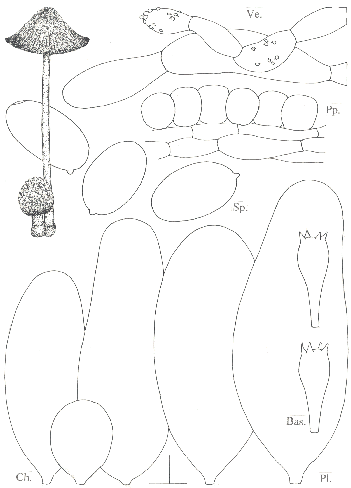Macroscopic features |
Pileus up to 25 x 20 mm when still closed, subglobose, ovoid or ellipsoid, expanding to conical or convex and then up to 45 mm wide, pale dirty ochre or ochre-brown with grey-ochre centre, first covered with a layer of felty veil, breaking up into small woolly flocks, those becoming ochre to brown at centre. Lamellae, L = c. 55--60, l = 3--5, free, first white then grey-brown to black, 3--8 mm broad. Stipe 30--80 x 2--7 mm, white, base clavate sometimes with a volva-like margin. |
Microscopic features |
Spores 9.8--16.7 x 6.4--9.8 µm, Q = 1.35--1.90, av. Q = 1.40--1.80, av. L = 10.9--15.3 µm, av. B = 7.0--9.2 µm, ellipsoid or ovoid, with rounded base and apex, very dark red-brown; germ pore eccentric, 1.2--1.5 µm wide. Basidia 18--40 x 11--16 µm, 4-spored, surrounded by 4--7 pseudoparaphyses. Pleurocystidia 50--100 x 30--70 µm, ellipsoid, ovoid, broadly utriform or subcylindric. Cheilocystidia 30--90 x 25--50 µm, (sub)globose, ellipsoid, ovoid, sometimes broadly utriform. Caulocystidia absent. Veil 20--80 x 5--55 µm, made up of chains of cylindrical to ellipsoid, fusoid or (sub)globose cells, if (sub)globose than towards end of the chain and 30--55 µm in diam., thin-walled or sometimes slightly thick-walled and brownish towards end of chain and from centre of pileus. Pileipellis a epithelioid hymeniderm. Clamp-connections absent, only pseudoclamps present. |
Habitat & distribution |
Solitary or a few together on wood-chips or other woody matter. Rather rare but wide-spread in Europe. |
Remarks |
The for the complex large spores with eccentric germ pore and the absence of caulocystidia make it easy to recognize Coprinus flocculosus. |

[Copyright © by Uljé]

[Copyright © by Schmidt-Stohn]